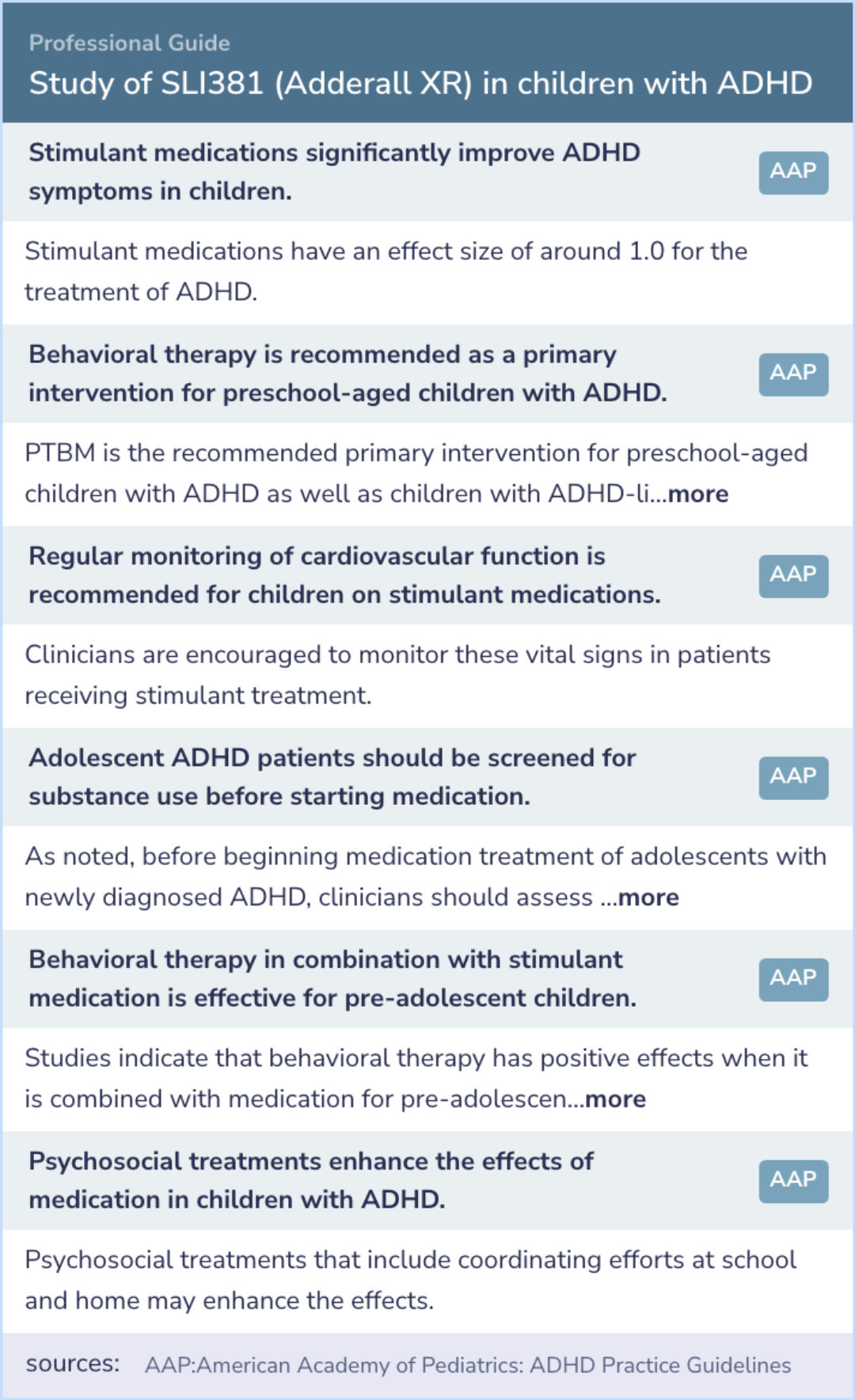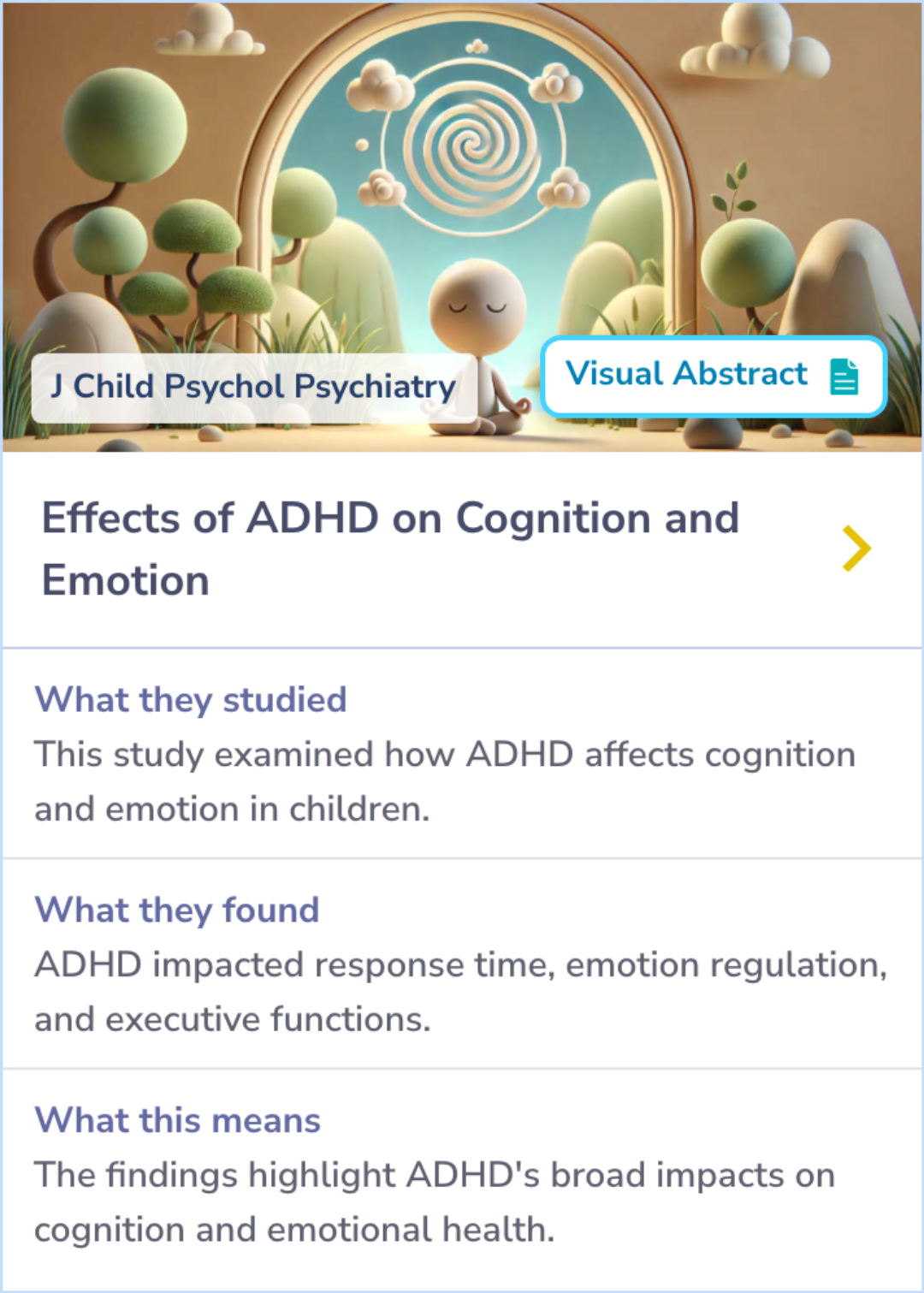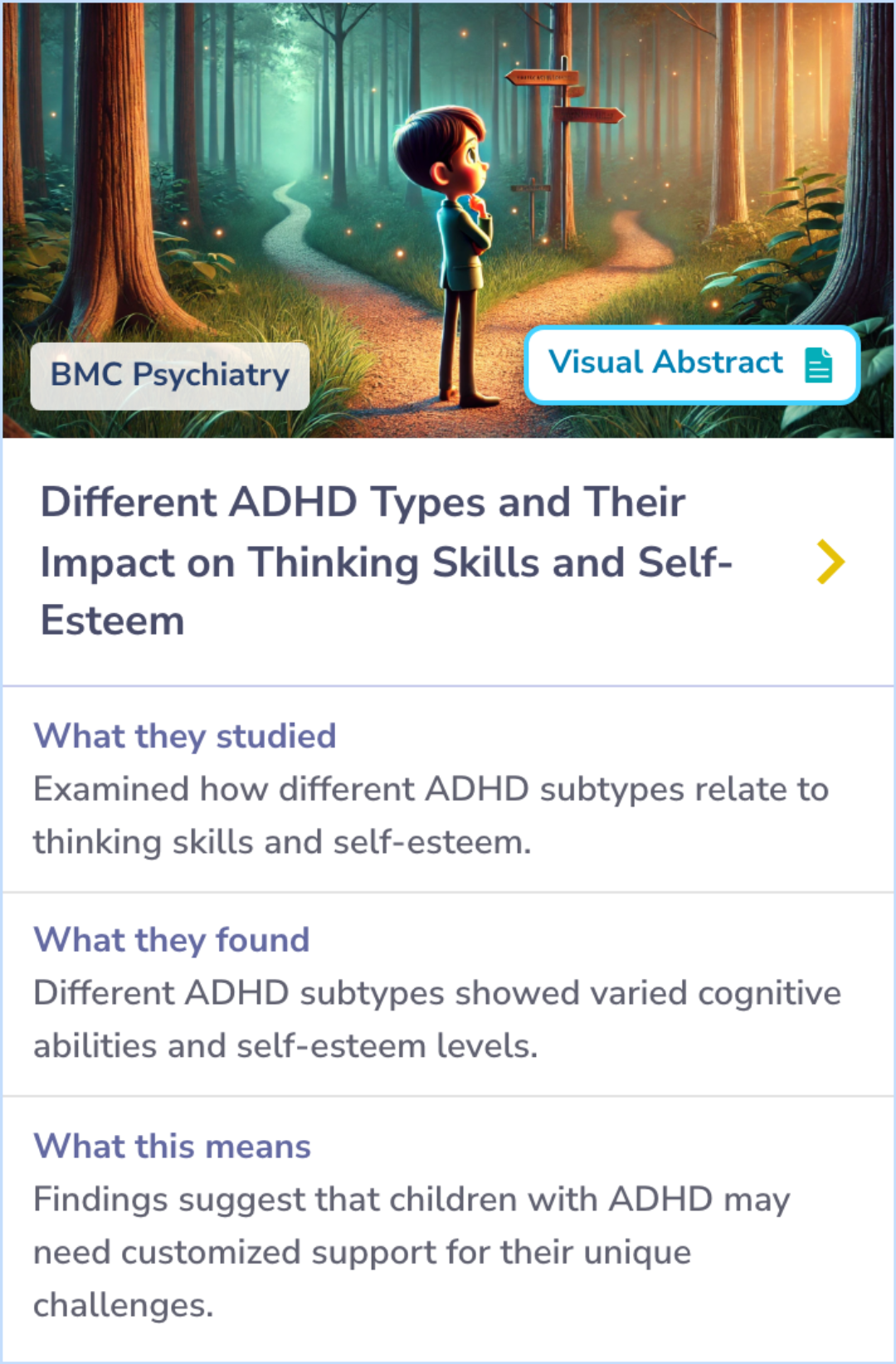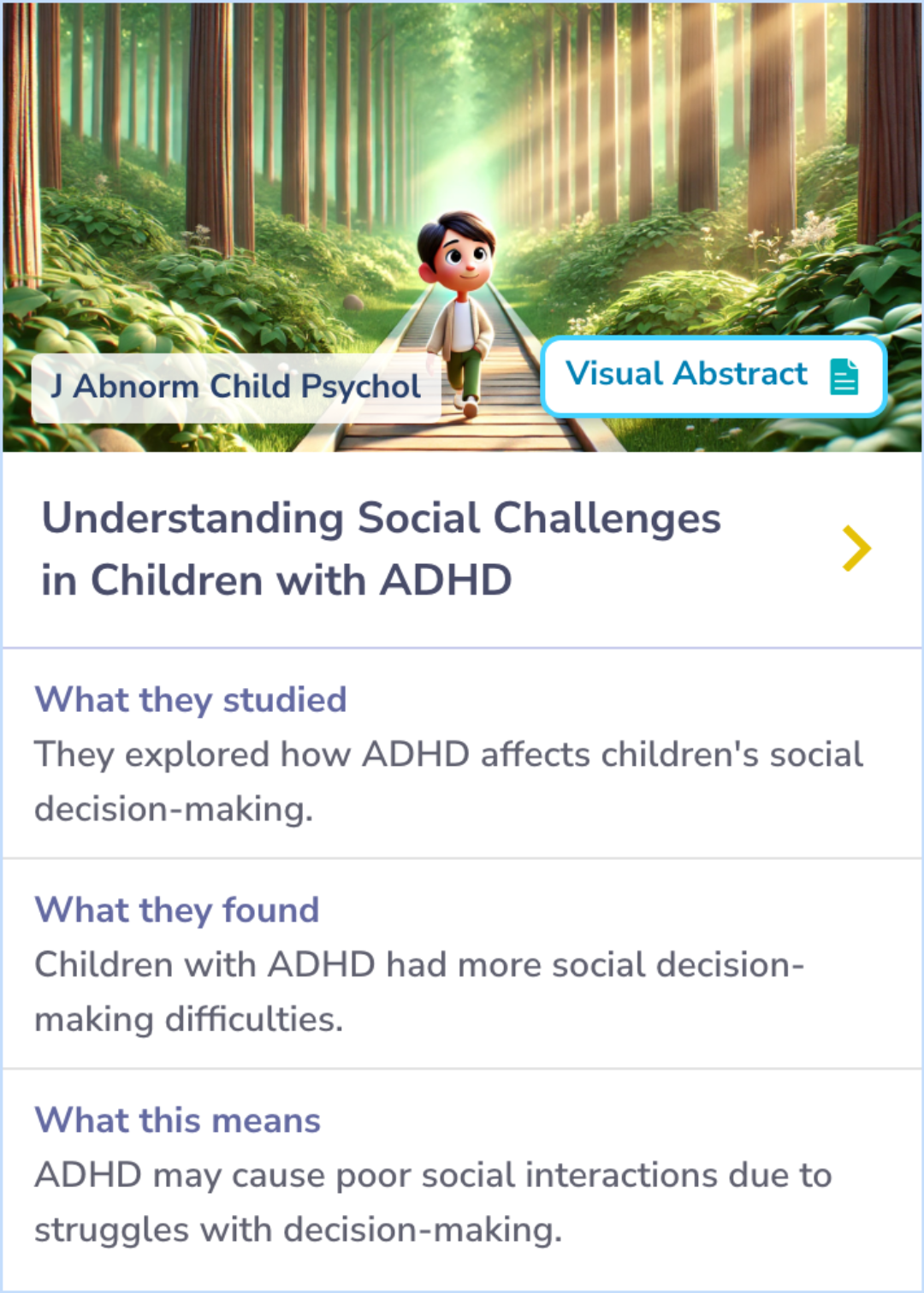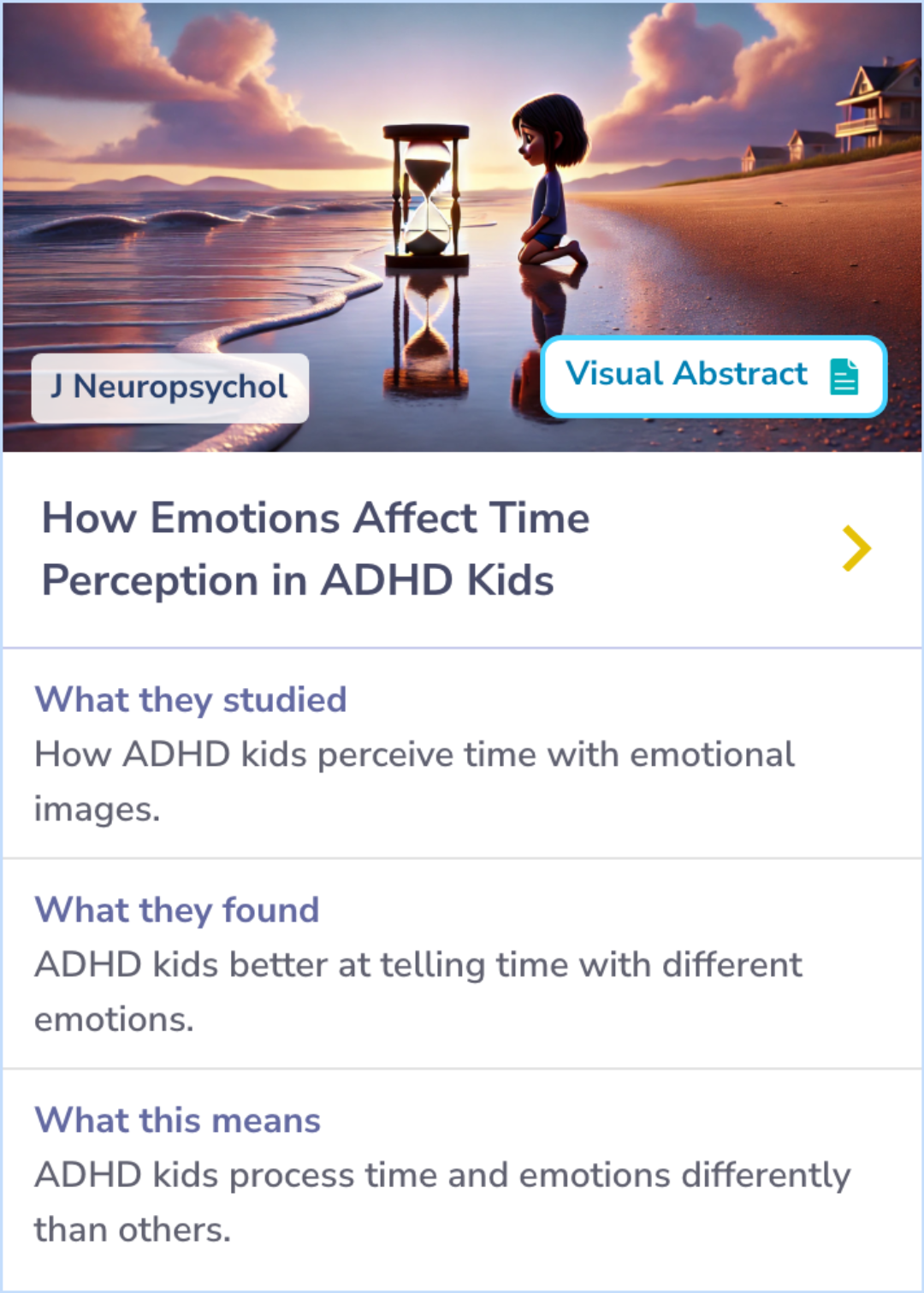Adderall Study Database
Visual Abstract
A randomized, double-blind, placebo-controlled, parallel-group study of SLI381 (Adderall XR) in children with attention-deficit/hyperactivity disorder
Study of SLI381 (Adderall XR) in children with ADHD
September 12, 2024
author
Biederman J, Lopez FA, Boellner SW, Chandler MC
journal
Pediatrics
Date Published
2002 Aug
Why link to a visual abstract?
What is a visual abstract?
Original
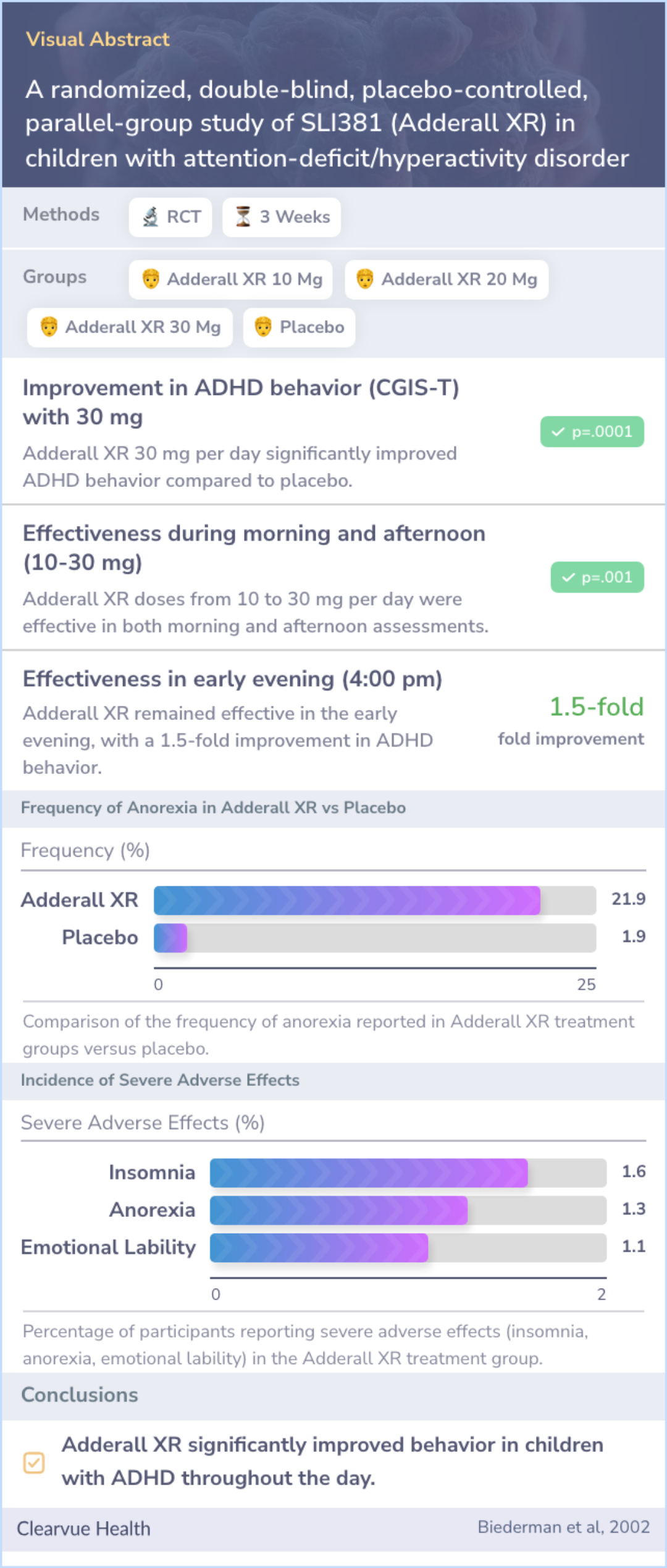
Study Summary
🔬
What They Studied
The researchers studied whether Adderall XR is effective and safe for treating ADHD in children, and how well it works throughout the day.
💡
What They Found
They found that Adderall XR significantly improved behavior in the morning, afternoon, and late afternoon compared to placebo, with dose-related improvements.
📚
What This Means
These findings suggest that Adderall XR is effective in managing ADHD symptoms throughout the day in children, aligning with current guidelines that recommend stimulant medications like Adderall for treating ADHD.
Study Summary
Study Overview
SLI381 was effective in treating children with ADHD throughout the day in natural home and school settings. This medication offers a safe, long-lasting option that helps control ADHD symptoms not just during school, but also during after-school activities and family time. The treatment was well tolerated with few side effects. It also showed consistent benefits for both boys and girls with ADHD, making it a promising choice for many young patients. A once-a-day dose simplifies medication routines for children, improving compliance and ensuring they remain focused all day long.
Abstract: background
SLI381 (Adderall XR) is a 2-component extended-release capsule formulation of Adderall designed to produce a therapeutic effect that lasts throughout the day with 1 morning dose. The primary objective of this study was to assess the efficacy and safe...more

Morning Dose Effectiveness
"The findings that one early morning dose of SLI381 was effective throughout the morning and afternoon as reported by parents and teachers confirm, in the naturalistic setting of home and school, previous results in a laboratory setting."
Facilitating Treatment
"Considering the inherent problems associated with in-school dosing of stimulant medications for ADHD, the availability of a safe and effective long acting stimulant such as SLI381 is likely to greatly facilitate the treatment of the large number of afflicted youth with ADHD."
Benefits Beyond School
"Such results indicate that the duration of action of SLI381 should allow for pharmacological support of homework activities, after school athletic and social activities, as well as family life-- critical components of the child's life."
Study Summary
Methods
Researchers conducted a rigorous, multicenter trial involving 47 sites, where children aged 6 to 12 diagnosed with ADHD participated. After a week-long break from any previous stimulant medication, participants were randomly assigned to receive either a placebo or one of three doses of Adderall XR (10 mg, 20 mg, or 30 mg) each morning for three weeks.
The study measured effectiveness primarily through the Conners Global Index Scale for Teachers and also considered parents' assessments, clinical impressions, and overall improvements from parents' perspectives. Safety was closely monitored through reports of adverse events, lab tests, and physical exams, including ECGs taken at both the beginning and end of the study.
The study measured effectiveness primarily through the Conners Global Index Scale for Teachers and also considered parents' assessments, clinical impressions, and overall improvements from parents' perspectives. Safety was closely monitored through reports of adverse events, lab tests, and physical exams, including ECGs taken at both the beginning and end of the study.
Abstract: methods
A multicenter, randomized, double-blind, parallel-group, placebo-controlled trial was conducted at 47 sites. After a 1-week washout of any previous stimulant medication, patients were randomized to receive single-daily morning doses of placebo or SLI...more

Study Summary
Results
Out of 584 children who entered the study, 563 were part of the analysis, and 509 completed the trial. The findings showed that all doses of Adderall XR significantly improved behaviors in the morning, afternoon, and late afternoon compared to the placebo group. This improvement was consistent across teacher and parent ratings and was dose-dependent, with higher doses leading to greater behavioral improvements.
In terms of overall impression and parental assessments, Adderall XR outperformed the placebo across all doses by the study's end, confirming the relationship between higher doses and better outcomes. Additionally, the rate of reported adverse events was low and comparable between those on Adderall XR and those on placebo, indicating a favorable safety profile.
In terms of overall impression and parental assessments, Adderall XR outperformed the placebo across all doses by the study's end, confirming the relationship between higher doses and better outcomes. Additionally, the rate of reported adverse events was low and comparable between those on Adderall XR and those on placebo, indicating a favorable safety profile.
Abstract: results
Five hundred eighty-four children were randomized, 563 were included in the intent-to-treat population, and 509 completed the entire study. Intention-to-treat analysis of Conners Global Index Scale for Teachers and Conners Global Index Scale for Pare...more
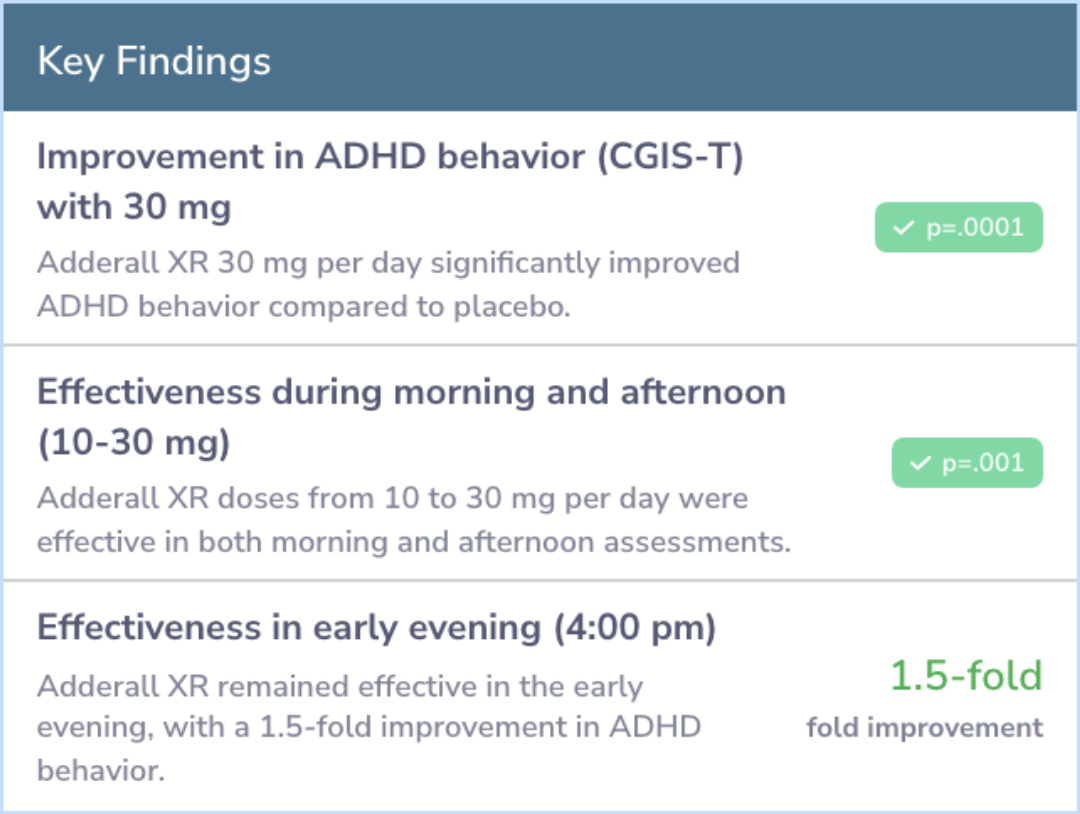
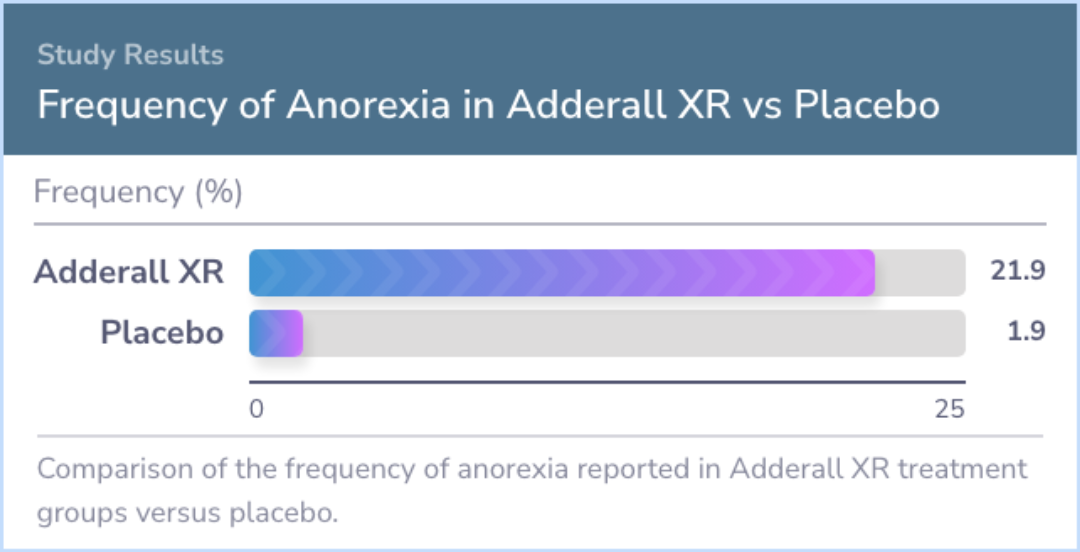
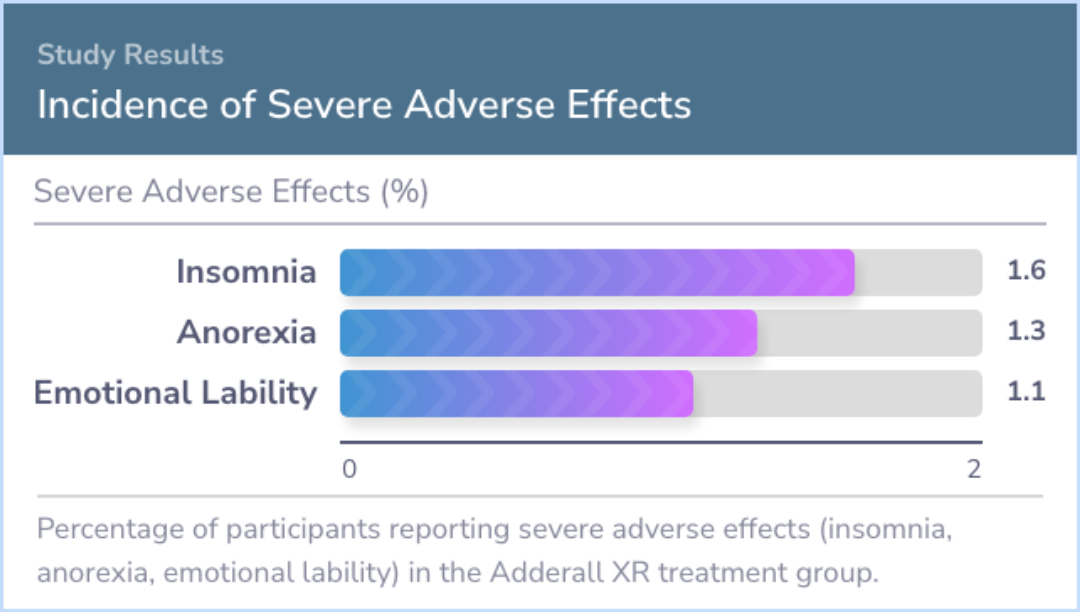
Study Summary
Conclusions
Adderall XR demonstrated clear, dose-related improvements in children's behavior throughout the day. The study confirmed that this extended-release formulation is effective in providing consistent symptom control in the morning, afternoon, and even late afternoon, as observed by both teachers and parents.
The consistent therapeutic effect throughout the day suggests that Adderall XR is a reliable once-daily treatment option for managing ADHD in children, providing substantial benefits without a significant increase in adverse effects compared to a placebo.
The consistent therapeutic effect throughout the day suggests that Adderall XR is a reliable once-daily treatment option for managing ADHD in children, providing substantial benefits without a significant increase in adverse effects compared to a placebo.
Abstract: conclusions
SLI381 produced consistent, dose-related improvements on all measures of efficacy. The extended-release nature of the SLI381 formulation was shown by continued, significant improvement in afternoon assessments by teachers and afternoon and late after...more
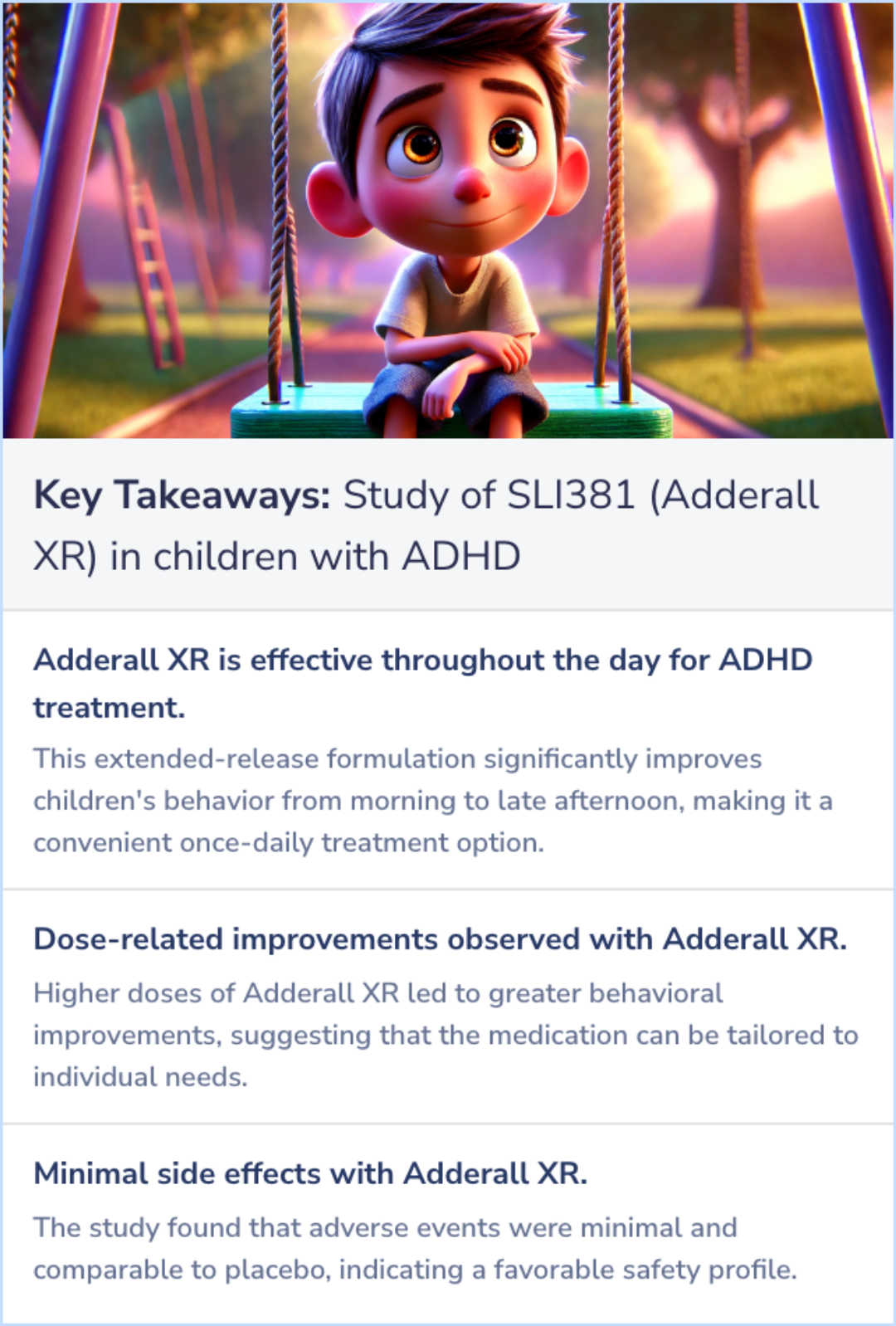
Background Information
Patient Guide
💊
FDA Approval for ADHD
Adderall is FDA-approved to increase attention and reduce impulsivity in ADHD patients.
🧬
Mechanism of Action
Adderall boosts dopamine and norepinephrine in the brain for improved focus and attention.
📦
Extended-Release Formulations
Adderall comes in extended-release forms, designed for sustained therapeutic effect.
💉
Dosing Recommendations
Adderall dosing ranges from 5 mg to 40 mg daily, tailored to therapeutic needs.
📏
Growth and Cardiovascular Monitoring
Children on Adderall require growth and cardiac assessments during treatment.

Professional Guide
Expert Opinion: Study of SLI381 (Adderall XR) in children with ADHD
In line with the study findings, stimulant medications such as Adderall XR demonstrate significant efficacy in treating ADHD symptoms in children, which aligns with clinical guidelines that highlight the substantial effect size of these medications.
Consistent with the abstract's focus on the safety of these treatments, guidelines also recommend regular cardiovascular monitoring for children on stimulant medications, due to the potential side effects that may arise.
The integration of behavioral therapy alongside stimulant medication proves effective for pre-adolescent children, underscoring the potential for improved outcomes when combining psychosocial interventions with pharmacologic treatments.
Consistent with the abstract's focus on the safety of these treatments, guidelines also recommend regular cardiovascular monitoring for children on stimulant medications, due to the potential side effects that may arise.
The integration of behavioral therapy alongside stimulant medication proves effective for pre-adolescent children, underscoring the potential for improved outcomes when combining psychosocial interventions with pharmacologic treatments.
Evidence Summary
ADHD's Diverse Neuropsychological Profile in Children
ADHD presents a complex picture with varying effects on neuropsychological domains. This study focused on children, revealing that those with ADHD had differences in executive functioning, response time, and emotion regulation compared to peers.
Interestingly, emotional functioning stood out, suggesting ADHD involves distinct cognitive and emotional challenges. The research supports the diverse nature of ADHD, emphasizing various independent contributions beyond just emotional regulation.
Interestingly, emotional functioning stood out, suggesting ADHD involves distinct cognitive and emotional challenges. The research supports the diverse nature of ADHD, emphasizing various independent contributions beyond just emotional regulation.
Evidence Summary
Differentiating ADHD: Cognitive Patterns and Self-Esteem
ADHD encompasses diverse symptoms and cognitive challenges, leading to distinct subtypes like hyperactive, inattentive, and combined. Each subtype experiences unique cognitive patterns, with working memory being particularly affected. Notably, hyperactive children display high cognitive strength and self-esteem, contrasting with the inattentive subtype. Cognitive differences are examined through specific tests, illuminating these variations.
Research also highlights the link between cognitive strength and self-esteem, as individuals with higher cognitive abilities often report greater self-worth. Understanding these subtype-specific nuances can aid in tailored approaches for ADHD management.
Research also highlights the link between cognitive strength and self-esteem, as individuals with higher cognitive abilities often report greater self-worth. Understanding these subtype-specific nuances can aid in tailored approaches for ADHD management.
Evidence Summary
ADHD and Social Challenges in Children
Children with ADHD often face challenges in social settings, experiencing difficulties in reading affective cues, which affects their decision-making. This study focused on children aged 6 to 10, both with and without ADHD, examining how baseline symptoms relate to social functioning over two years. Parental and teacher reports highlighted a connection between ADHD symptoms and increased social problems, mediated by individual differences in interpreting social cues.
Evidence Summary
ADHD Kids' Surprising Time Sensitivity
Children with ADHD show heightened sensitivity to time when managing tasks involving emotions. In an experiment, 34 children with ADHD and 31 control peers compared images of different emotional tones.
Interestingly, children with ADHD performed better across the board. Their ability to discriminate time differences was roughly 35 milliseconds more precise than the control group, hinting at unique challenges and adaptations in ADHD-related cognitive processing.
Interestingly, children with ADHD performed better across the board. Their ability to discriminate time differences was roughly 35 milliseconds more precise than the control group, hinting at unique challenges and adaptations in ADHD-related cognitive processing.
